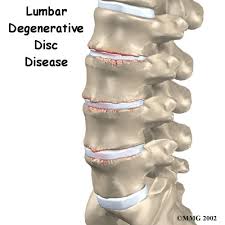A condition of radicular leg pain, sometimes accompanied by low back pain and may be accompanied by motor or sensory deficit.
 Lumbar Disc Syndrome : Initial Diagnosis and Management
Lumbar Disc Syndrome : Initial Diagnosis and Management
- The initial diagnosis is clinical with the acute or subacute development of low back pain usually with sciatic pain following minimal low back trauma in patients under the age of 50. No x-ray or lab studies are necessary. Over the age of 50, disc abnormalities are possible, but initial lumbar disc syndrome series should be considered which might exclude bony structural abnormalities such as severe degenerative changes, osteoporosis with compression or metastatic involvement. MRI and/or CT scan are not necessary to confirm the initial diagnosis of lumbar disc syndrome except when there is failure to respond to conservative therapy or there is development of neurologic deficit (see Indications for Specialty Care Referral below).
- The initial objective of management is to reduce lumbar disc syndrome tension. Depending upon the severity, bed-rest or reduction of activity level for one to two weeks is indicated. Analgesics and muscle relaxants are usually helpful.
Ongoing Management and Objectives
- During the acute period, the major consideration is that the sciatic pain is decreasing and overall mobility is increasing. Conservative therapy as described above is indicated.
Indication a profile is needed
- Any limitations that affect strength, range of motion, and general efficiency of the back.
- Slightly limited mobility of joints, muscular weakness, or other musculo-skeletal defects that may prevent hand-to-hand fighting and disqualifies for prolonged effort.
- Defects or impairments that require significant restriction of use for lumbar disc syndrome.
Specifications for the profile
- Weeks 1-2
- Run at own pace and distance
- No marching greater than 2 miles
- No sit ups
- No ruck sacks
- No lifting greater than 15lbs
- No repetitive bending
- Weeks 2-4
